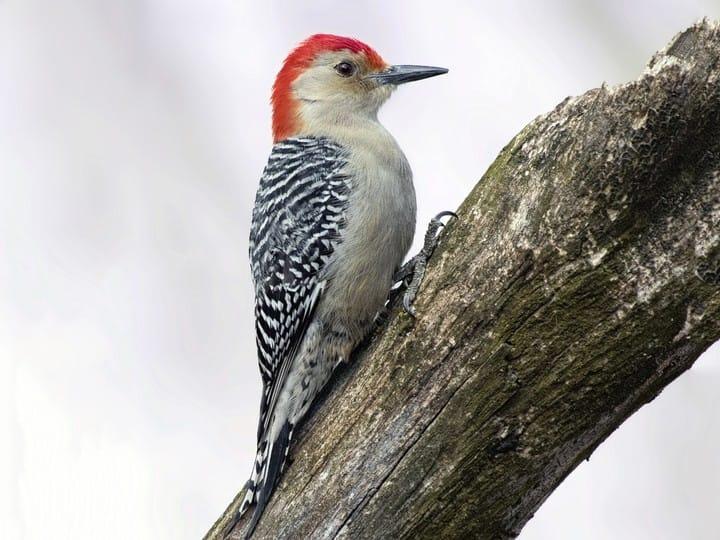Running Into Woodpeckers in Florida Variety: Environments and Habits
Running Into Woodpeckers in Florida Variety: Environments and Habits
Blog Article
Woodpeckers Unleashed: Discovering the Marvels of These Competent Tree Mountain Climbers
Woodpeckers, with their distinctive markings and rhythmic drumming echoing via wooded areas, hold an one-of-a-kind place in the bird globe - Woodpeckers in Florida. As we dive into the intricate details of woodpeckers' nesting routines, feeding strategies, and the continuous conservation initiatives to protect these amazing birds, a much deeper recognition for their location in nature unfolds.
Makeup and Adaptations
When analyzing the anatomy and adaptations of woodpeckers, one can observe remarkable features that make it possible for these birds to thrive in their specialized eco-friendly specific niche. In addition, woodpeckers have zygodactyl feet, with two toes encountering ahead and two encountering backward, giving a company grip on tree trunks while they browse for food or drum for communication.
Additionally, woodpeckers have an unique tongue structure that is long, barbed, and sticky, allowing them to remove pests from holes in timber. This customized adaptation permits woodpeckers to make use of a food source that is unattainable to numerous various other bird species. On the whole, the makeup and adaptations of woodpeckers showcase the impressive transformative solutions that have actually permitted these birds to prosper in their arboreal environment.
Drumming Behavior
Having discovered the makeup and adjustments of woodpeckers, the emphasis now moves to recognizing their drumming actions, an unique facet of their communication and territorial display screens. Drumming is an important form of communication amongst woodpeckers, serving multiple functions such as establishing areas, drawing in companions, and signaling alarm system. Each woodpecker species has a distinct drumming pattern that aids individuals identify participants of their own species and distinguish them from competitors or predators.
Woodpeckers create drumming audios by quickly pecking on resonant surfaces such as dead trees, utility poles, or also metal things, creating a series of rhythmic beats. The intensity and speed of drumming can vary based upon the objective; for instance, a rapid drumming series might indicate aggressiveness in the direction of intruders, while a slower and softer drumming pattern could show courtship (Woodpeckers in Florida). In addition, woodpeckers might change the frequency and period of their drumming to share details messages successfully
Nesting Habits
Exploring the nesting habits of woodpeckers discloses remarkable insights into their reproductive habits and environment choices. Woodpeckers are known for their special nesting choices, frequently digging deep into cavities in trees to create sheltered areas for raising their young. These dental caries serve not only as a nesting site however likewise as a protected sanctuary from killers and stormy weather.
Woodpeckers show a high level of fidelity to their nesting sites, typically going back to the same area year after year. This actions highlights the importance of ideal habitat accessibility for their reproductive success. The selection of a nesting website is essential for woodpeckers, with variables such as tree varieties, height, and degeneration stage playing substantial duties in their decision-making process.
Surprisingly, some woodpecker species are recognized to dig deep into several dental visite site caries within their area, providing themselves with alternate nesting choices. This strategy may function as a kind of insurance policy against prospective dig this hazards or disruptions to their main nesting website.

Feeding Strategies
Woodpeckers utilize a variety of specialized feeding strategies to obtain their main food resources. One of one of the most distinct feeding actions of woodpeckers is drumming, which includes rapid pecking on trees to reveal bugs underneath the bark. This drumming not only aids them find prey but also functions as a way of communication with various other woodpeckers. Woodpeckers have solid, chisel-like beaks that enable them to pierce right into wood easily. When an opening is created, they use their long, barbed tongues to draw out insects such as ants, beetles, larvae, and spiders. These tongues are coated with sticky saliva that aids trap the victim. Woodpeckers are also understood to dig deep into tooth cavities in trees to access concealed insect larvae or sap. Some types, like the acorn woodpecker, shop nuts in specially created holes called granaries. This strategic keeping of food assists them endure throughout food shortage periods. Woodpeckers are genuinely amazing in their feeding techniques, showcasing flexibility and intelligence in procuring their nourishment.
Preservation Efforts
Amidst the intricate feeding techniques displayed by woodpeckers, the conservation efforts intended at guarding these remarkable birds play a vital function in maintaining their environments and populations. Woodpeckers encounter numerous risks to their survival, consisting of environment loss because of deforestation, i thought about this climate adjustment altering their environments, and accidents with synthetic frameworks such as structures and lorries - Woodpeckers in Florida. Conservationists are actively working to attend to these difficulties and guarantee the lasting health of woodpecker species

Education and public awareness campaigns are additionally essential elements of woodpecker preservation initiatives. By increasing awareness regarding the value of these birds in keeping healthy woodland environments, guardians can garner assistance for environment conservation efforts and promote responsible land administration methods. With collaborative initiatives between scientists, policymakers, and local areas, we can interact to secure a future where woodpeckers flourish in their all-natural habitats.
Final Thought

Report this page